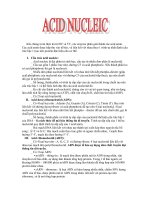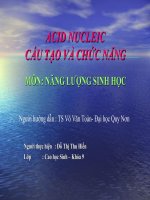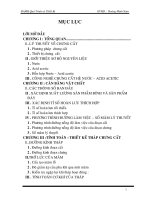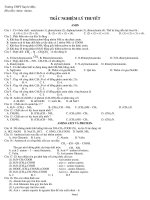SULPHONIC ACID ESTERS
Bạn đang xem bản rút gọn của tài liệu. Xem và tải ngay bản đầy đủ của tài liệu tại đây (640.53 KB, 12 trang )
6 Sulphonic Acid Esters
Typical structures of sulphonic acid esters used in polysaccharide chemistry are
showninFig.6.1.Themostwidelyusedarethep-toluenesulphonic- and the
methanesulphonic acid esters, due to their availability and hydrolytic stability. The
formation of sulphonic acid esters is carried out heterogeneously by conversion
with sulphonic acid chlorides in a tertiary organic base, in aqueous alkaline media
(NaOH, Schotten-Baumann reaction), or completely homogeneous in a solvent
such as DMAc/LiCl. A major drawback of heterogeneous procedures is that long
reaction times and a high molar excess of reagent, mostly sulphonic acid chloride,
are necessary for significant conversion. Sulphonic acid esters are reactive and
may be attacked by unmodified OH groups in situ, yielding cross-links. Hence, the
products obtained are insoluble. In addition, they contain a high chlorine content
formed by the nucleophilic attack of chloride ions. In contrast, the homogeneous
conversion, e.g. of cellulose dissolved in DMAc/LiCl, yields soluble sulphonic acid
esters [162]. In particular, homogeneous tosylation applying TosCl in the presence
of TEA is very efficient.
It is well known from the chemistry of low-molecular alcohols that hydroxyl
functionsareconvertedtoagoodleavinggroupbytheformationofthecorre-
sponding sulphonic acid esters, and hence nucleophilic displacement reactions
can be carried out. In the case of polysaccharides, nucleophiles such as halide ions
may attack the carbon atom, leading to the corresponding deoxy compound with
substitution of the sulphonate group (Fig. 6.2). It is also possible to modify the
remaining hydroxyl groups prior to the S
N
reaction.
6.1 Mesylates
The heterogeneous conversion of mercerised cellulose (cotton linters) with MesCl
(6 mol per mol AGU) in Py slurry affords cellulose mesylate with DS
Mes
values up
to 1.7 after reaction for several days at RT [264]. A crucial point is the activation
of the starting cellulose. It was found that the treatment of cellulose with aqueous
NaOH increases the reactivity [264]. In order to gain higher DS values, subsequent
solvent exchange with anhydrous methanol and Py is necessary. The alkali content
of the activated cellulose on the DS
Mes
is unimportant (Table 6.1).
118 6 Sulphonic Acid Esters
Fig. 6.1. Typical sulphonic acid esters of polysaccharides
Table 6.1. Influence of reaction time and temperature on the conversion of mercerised cellulose
(cotton linters) with MesCl in Py (adapted from [265])
Conditions Reaction product
Time (h) Temperature (°C) S (%) Cl (%) DS
Mes
DS
Cl
4 28 20.0 1.42 2.00 0.11
17 28 23.0 2.91 2.74 0.29
2 57 12.0 10.73 0.93 0.72
20 57 12.5 12.93 1.00 0.86
6.1 Mesylates 119
Fig. 6.2. Typical examples for S
N
reactions of polysaccharide sulphonic acid esters
The mesylation proceeds readily at 28
◦
C; at an elevated temperature of 57
◦
C,
side reactions become predominant, yielding products of comparably low DS
Mes
but with a high content of chlorodeoxy moieties [265].
The conversion of cellulose with MesCl in the presence of TEA in DMAc/LiCl
yields products with a DS
Mes
of 1.3 at areactiontemperatureof7
◦
C for 24 h
(Table 6.2, [266]). By a subsequent mesylation, a DS
Mes
of 2.1 may be realised [267].
A disadvantage of the homogeneous mesylation is the fact that the reaction has
to be carried out at polymer concentrations lower than 1% in order to prevent
Table 6.2. Conversion of cellulose with MesCl homogeneously in DMAc/LiCl at a temperature of 7 °C
(adapted from [267])
Conditions Reaction product
Molar ratio
AGU MesCl TEA Time (h) S (%) Cl (%) DS
Mes
DS
Cl
1 9 18 24 15.8 1.4 1.3 0.10
1 9 18 48 14.4 2.8 1.2 0.20
1 15 30 24 15.5 1.0 1.3 0.06
1 15 30 48 15.3 0.5 1.3 0.04
120 6 Sulphonic Acid Esters
gelation during the addition of the reagent. The products have to be precipitated
and washed carefully with ethanol/hexane or methanol/acetic acid. The pH value
has to be maintained around 7 in order to prevent hydrolysis of the ester moieties.
The cellulose mesylates were found to be soluble in DMSO starting at DS
Mes
1.3,
and additionally in DMF and NMP starting at DS
Mes
2.1. Samples with lower DS
Mes
swell only.
Dextran mesylate is prepared in an aqueous solution of the biopolymer with
MesCl and NaOH as base [262]. Precipitation in ethanol yielded a dextran mesy-
late, which is partly water soluble. The water-soluble fraction (main component)
possesses a DS
Mes
of 0.10, while the DS
Mes
of the insoluble part is 0.68.
The structure of the reaction products of cross-linked pullulan particles with
MesCldependsonthesolventused.InthecaseofPy,mesylationat20
◦
C yields
apullulanmesylatewithDS
Mes
0.68 and negligible incorporation of chlorodeoxy
groups (DS
Cl
0.04), applying 3 mol reagent per mol RU. At higher temperatures, S
N
reactions become predominant, decreasing the DS
Mes
and increasing the DS
Cl
.In
contrast, mesylation in DMAc and DMF yields products containing both mesyl and
chlorodeoxy moieties already at a low reaction temperature [268]. For instance, if
the reaction is carried out in DMF at 20
◦
C,aDS
Mes
of 0.04 and a DS
Cl
of 0.10 were
obtained.
6.2 Tosylates
Tosylationofcellulosecan be carried outhomogeneously in the solventDMAc/LiCl,
permitting the preparation of cellulose qtosylate with defined DS
Tos
controlled by
the molar ratio reagent to AGU at short reaction times, with almost no side
reactions [162, 256, 271]. However, the product structure may depend on both the
reaction conditions and the workup procedure applied (Fig. 6.3).
Sulphonic acid chloride and DMAc react in a Vilsmeier-Haack-type reaction
forming the O-(p-toluenesulphonyl)-N,N-dimethylacetiminium salt I. This inter-
mediate reacts with hydroxyl groups, depending on the conditions applied. Using
weak organic bases, e.g. Py (pK
a
5.25) or N,N-dimethylaniline (pK
a
5.15), the reac-
tion with the polysaccharide yields a reactive N,N-dimethylacetiminium salt II. II
can form chlorodeoxy compounds III at high temperatures or yields the acetylated
polysaccharide IV after aqueous workup. In contrast, stronger bases such as TEA
(pK
a
10.65) or DMAP (pK
a
9.70) react with I, yielding a less reactive species V
compared with II, and hence lead to the formation of polysaccharide sulphonic
acid esters VI without undesired side reactions.
Detailed studies on the preparation of cellulose tosylates demonstrate that
various cellulose materials with DP values ranging from 280 to 1020 could be
converted to the corresponding tosyl esters [256]. At 8–10
◦
C,DS
Tos
values in the
range 0.4–2.3, with negligible incorporation of chlorodeoxy groups, were obtained
within 5–24 h (Fig. 6.4, Table 6.3).
The cellulose tosylates are soluble in a wide variety of organic solvents. From
DS
Tos
0.4, they dissolve in aprotic dipolar solvents (DMAc, DMF, and DMSO). The
6.2 Tosylates 121
Fig. 6.3. Mechanism for the reaction of cellulose with TosCl in DMAc/LiCl depending on organic
bases (adapted from [272])
polymer becomes soluble in acetone and dioxane at DS
Tos
1.4 and, in addition, in
chloroform and methylenechloride at DS
Tos
1.8. A structure characterisation was
carried out by means of FTIR- and NMR spectroscopy (Fig. 6.5).
In the
13
C NMR spectra (Fig. 6.5), typical signals of the modified AGU are
observed in the range from 61.0 to 103.0 ppm.Inaddition,thepeaksofthetosyl
ester moiety can be found at 20.5 ppm (methyl group) and in the range from 127.0
to 145.0 ppm (aromatic carbon atoms). It is obvious that position 6 is esterified
first because a signal appears at 70 ppm, which is caused by the functionalisation.
Significant splitting of the C-1 signal was not detected, indicating that position
2doesnotreactatlowDS
Tos
. With increasing DS
Tos
, the intensity of the C-6









